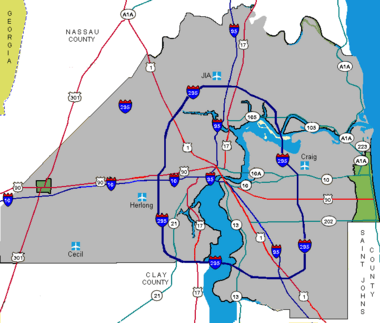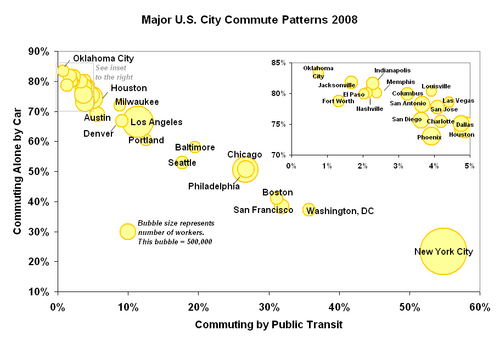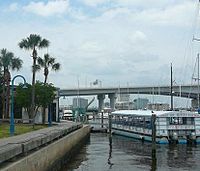Transportation in Jacksonville, Florida facts for kids
The Jacksonville transportation network includes ground, air, and sea options for passenger and freight transit. The Jacksonville Port Authority (Jaxport) operates the Port of Jacksonville, which includes container shipping facilities at Blount Island Marine Terminal, the Talleyrand Marine Terminal and the Dames Point Marine Terminal. Jacksonville Aviation Authority managers Jacksonville International Airport in Northside, as well as several smaller airports. The Jacksonville Transportation Authority (JTA) operates bus, people mover, and park-n-ride services throughout the city and region. A major bus terminal at the intermodal Rosa Parks Transit Station serves as JTA's main transit hub. Various intercity bus companies terminate near Central Station. Amtrak operates passenger rail service to and from major cities throughout North America. The city is bisected by major highways, I-95 and I-10, I-295 creates a full beltway around the city.
Along with bus services, Jacksonville offers fixed routes operated by the Jacksonville Transportation Authority (JTA). The Skyway is a people mover system located in Downtown Jacksonville. Its two lines and eight stations connect the Northbank, Southbank, and Lavilla districts. JTA is in the process of securing funding for an extension into Brooklyn, a neighborhood just south of Lavilla.
Contents
Background
Jacksonville is a sprawling city making cohesive walking and bicycling options difficult. Cycling still remains popular in some central urban areas for both recreation and commuting. The city manages to sustain a relatively low amount of traffic congestion for a city of its population, this is mostly related to the vast 767 square miles (1,990 km2) area the city covers, an area much larger than most cities with a population over 800,000. Jacksonville's low population density might also be the reason the city has yet to further develop its mass transit bus system or a heavy or light rail network. Among urbanized areas with a population of 1 million or greater in the United States, Jacksonville ranked tenth in freeway lane miles per 1,000 population and eighth in freeway-equivalent miles per 1,000 population. As the 12th-largest city in the U.S., Jacksonville has repeatedly been ranked below 40th in mass transit availability. As a result, the city is not well known for its walkability.
Jacksonville once had a large streetcar system. On February 24, 1893, Jacksonville began service with its first streetcar line. By the late 1920s, Jacksonville had what was Florida's largest streetcar system, run by multiple different companies. However, by the early 1930s, buses replaced streetcars, and the streetcars slowly perished. The last year of service was 1936.
|
Mobility issues include:
There are other concerns over a lack of safe walking paths in many areas of the city. Many suburbs which were incorporated in the consolidation of 1968 don’t have sidewalks. This often forces pedestrians to navigate a narrow road shoulder near high-speed automobile traffic. Future and proposed projectsSeveral proposals for expanding the Jacksonville transit system are in various stages of discussion, planning, or initial funding.
Water transportationPort of JacksonvilleMain page: Port of Jacksonville
Public seaports in Jacksonville are managed by the Jacksonville Port Authority, known as JAXPORT. Imported and exported goods are shipped from well over 100 countries through the Port of Jacksonville. JAXPORT operates three main cargo facilities: the Blount Island Marine Terminal, the Talleyrand Marine Terminal and the Dames Point Marine Terminal. Through these terminals over 21 million tons of cargo is shipped each year. Port activity is estimated to have an annual impact of over $19 billion, including 65,000 jobs. The Port of Jacksonville also serves as a hub for passenger ships. The JAXPORT Cruise Terminal is a 63,000 sq ft (5,900 m2) cruise ship terminal located at the northwest corner of the Dames Point Marine Terminal, beside the Dames Point Bridge. Vehicle access to the site is via Hecksher Drive and there is paved parking for about 600 cars. Sailings commenced in October 2003 and Carnival Cruise Lines presently offers service aboard the Fasciantion with service to the Bahamas and Key West. Passenger boat services
Images for kids |





